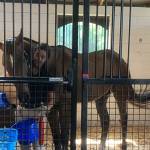Gastric Impaction in Horses: Poor Outcomes and Possible Diet Changes

Gastric impactions (GIs) occur when feed material persists in the stomach after prolonged fasting, generally defined as more than 24 hours. These colic-causing impactions can occur in isolation or in conjunction with other intestinal problems. With little data on gastric impactions, veterinary surgeons reviewed records from 71 affected horses to determine short- and long-term outcomes and to record how surviving horses are fed to avoid recurrence.*
Of the 71 horses diagnosed with GIs at two referral hospitals in the United Kingdom, 27 had only GI while the remaining 44 horses had GI in conjunction with concurrent intestinal lesions (CILs). Examples of CILs included large intestinal volvulus and displacement.
Researchers observed:
- Short-term survival to discharge was only 61% with no difference in survival between groups of horses with GI versus CIL;
- Gastric rupture occurred far more frequently in GI cases (30%) than in CIL cases (11%);
- Long-term follow-up was available for 30 of the 71 cases and the mean time to death following discharge from the hospital was 3 years; and
- The overall rate of gastric impaction recurrence was 22%, and 9 of the 43 horses discharged from the hospital were readmitted afterward for another gastric impaction.
“Only 50% of horses returned to a normal diet and exercise program after impaction. Further, horses with only GI were nearly nine times more likely to require ongoing dietary management change compared to horses with CIL,” explained Catherine Whitehouse, M.S., a nutrition advisor for Kentucky Equine Research.
Specifically, horses with a history of surviving gastric impaction were fed short-fiber or grass-only diets and partial- or complete-pelleted feeds.
“Feeding a partial- or complete-pelleted diet can be a logistical and financial challenge for horse owners, and can lead to alterations in horses’ behavior and gastrointestinal pH,” wrote the veterinary surgeons in their study.
According to Whitehouse, “Feeding processed forages reduces eating time and decreases chewing behavior compared to feeding long-stemmed forage. Reduced chewing can decrease saliva production, which buffers gastric contents, and one study found a lower (more acidic) hindgut pH in horses fed complete pelleted diets compared to long-stemmed grass hay.”
Adding a digestive buffer to predominantly pelleted or cubed diets may help support digestive health. Feeding strategies to extend the time spent eating are important in the management of these horses, Whitehouse said.
The exact pathways resulting in GI remain unknown, and the link between GI and other intestinal lesions such as large intestinal volvulus and displacement is unclear. One key question remaining to be answered is whether GI occurs first, potentially triggering another intestinal incident (e.g., volvulus), or whether GI is a result of another intestinal disturbance.
“According to the surgeons, there is some evidence that GIs predispose horses to large intestinal displacements or torsions because of their space-occupying nature. But it is also possible that a torsion of the intestine could delay gastric emptying, resulting in GI,” Whitehouse said.
Regardless of which comes first, an underlying motility issue is suspected, which is likely why recurrence was so high in this study and why many horses cannot resume their normal feeding following impaction.
*Talbot, S.E., R. Tallon, and B. Dunkel. 2023. Clinical presentation and outcome of gastric impactions with or without concurrent intestinal lesions in horses. Journal of Veterinary Internal Medicine 37(4):1544-1551.








